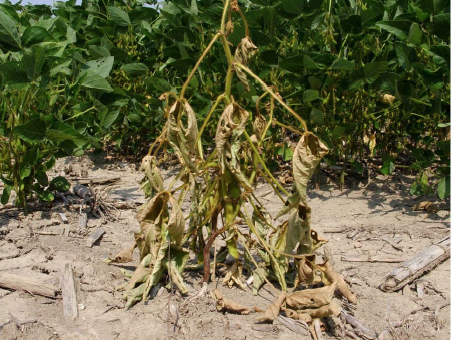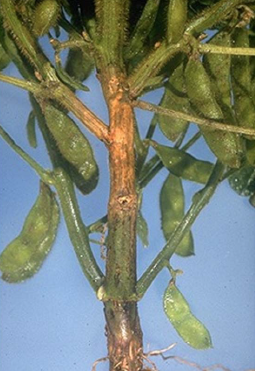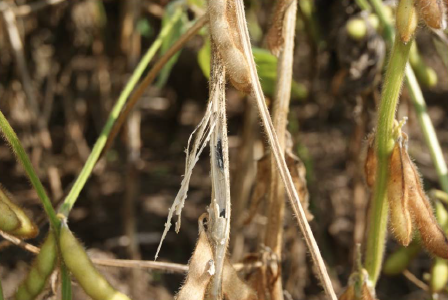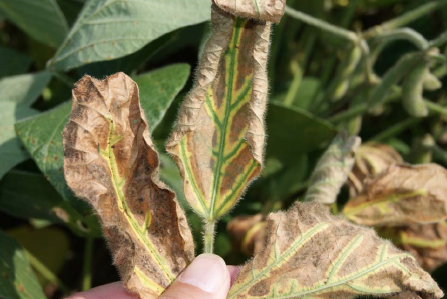By Anne Dorrance
Early death of soybean plants in the pod filling stage has been reported in numerous fields around the state. All of these situations are caused by different soybean pathogens and all can be managed with host resistance. The key is to know how to identify these problems and then choose soybean varieties with better resistance scores.
 Phytophthora stem rot |
1. Phytophthora stem rot. This is the most common of the soil borne diseases in Ohio. This disease can be found throughout the state, but large pockets and total losses can occur in fields with poor drainage.
The distinguishing characteristic at the reproductive growth stages is the chocolate brown canker that goes from the soil line up the stem. Occasionally we find plants where the canker is limited to one side, but the key is the roots are rotted and the discoloration goes up from the roots up the plant. Only plants with low levels of partial resistance (also called tolerance) are affected at this stage, so watch those scores.
 Diaporthe stem canker |
 Sclerotinia stem rot |
 Brown stem rot |
2. Diaporthe stem canker. This disease is present in Ohio and can survive on soybean residue and on seed. The diagnostic feature is the canker that occurs at the 3rd or 4th node on the plant. This girdles the plant. Interestingly, the branches at the bottom of the plant will be alive but the top will be dead. Choosing varieties with the higher levels of resistance will take care of this one as well.
3. Sclerotinia stem rot. I would be surprised if we don’t see some of this disease this year. During the pod filling stage, stems will have white “fluffy” growth on them. As the disease progresses, plants will be upright with a grayish color and girdled — again most often at the lower nodes. The inside of the stems will be soft and may have hard black structures called sclerotia.
Highly susceptible varieties may have as much as 60% to 70% incidence in a field when highly ideal conditions occur during flowering. Soybean varieties with higher levels of resistance may still develop Sclerotinia stem rot, but at much lower levels of incidence. This is a great year to look at variety scores and see how much disease does develop in those fields with a long history of disease.
4. Brown stem rot. This is a disease that we really don’t see symptoms of in Ohio. This may be due to the pH. When soil pH is low — 5.5 or below — symptoms develop. Foliar symptoms are very similar to sudden death syndrome, with necrosis between the veins and surrounded by yellow. The key diagnostic feature is the brown pith in the plants. These symptoms can run the whole length of the plant, but may also only appear at nodes.






Post a comment
Report Abusive Comment